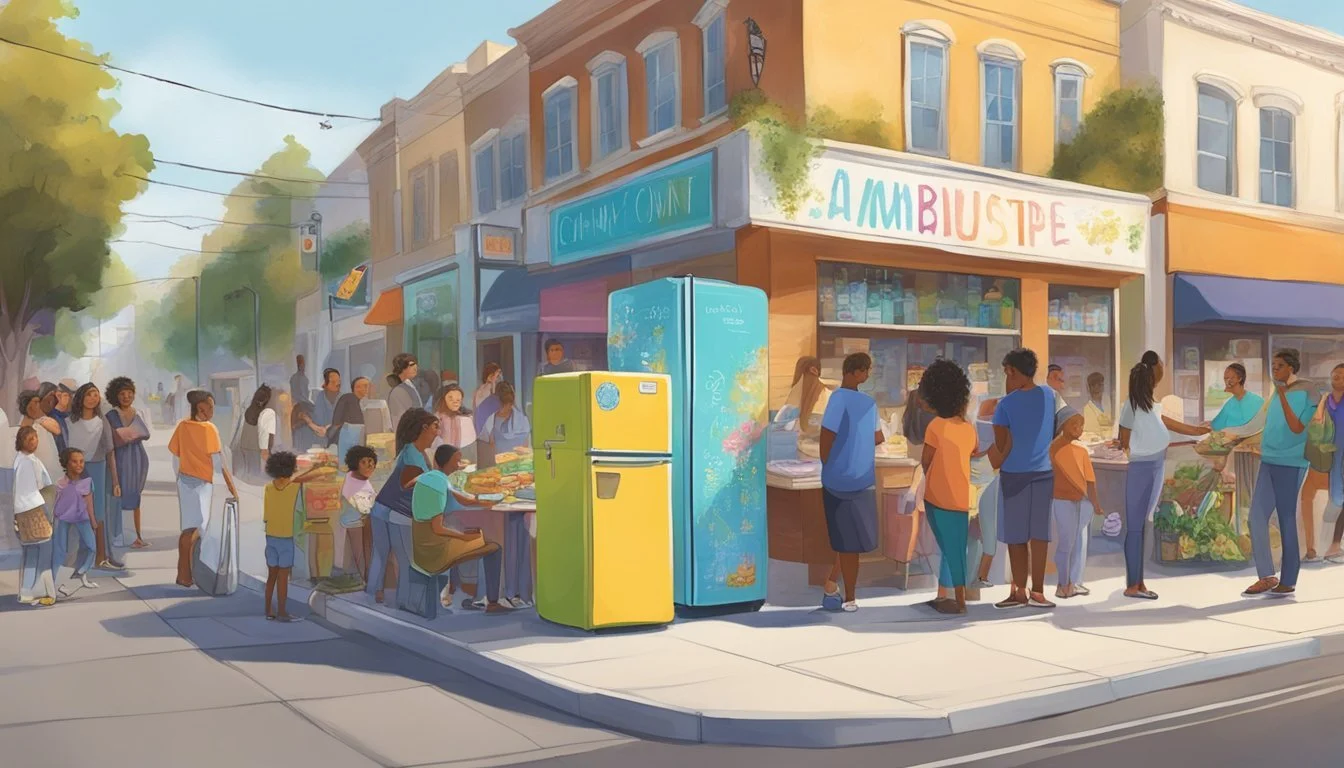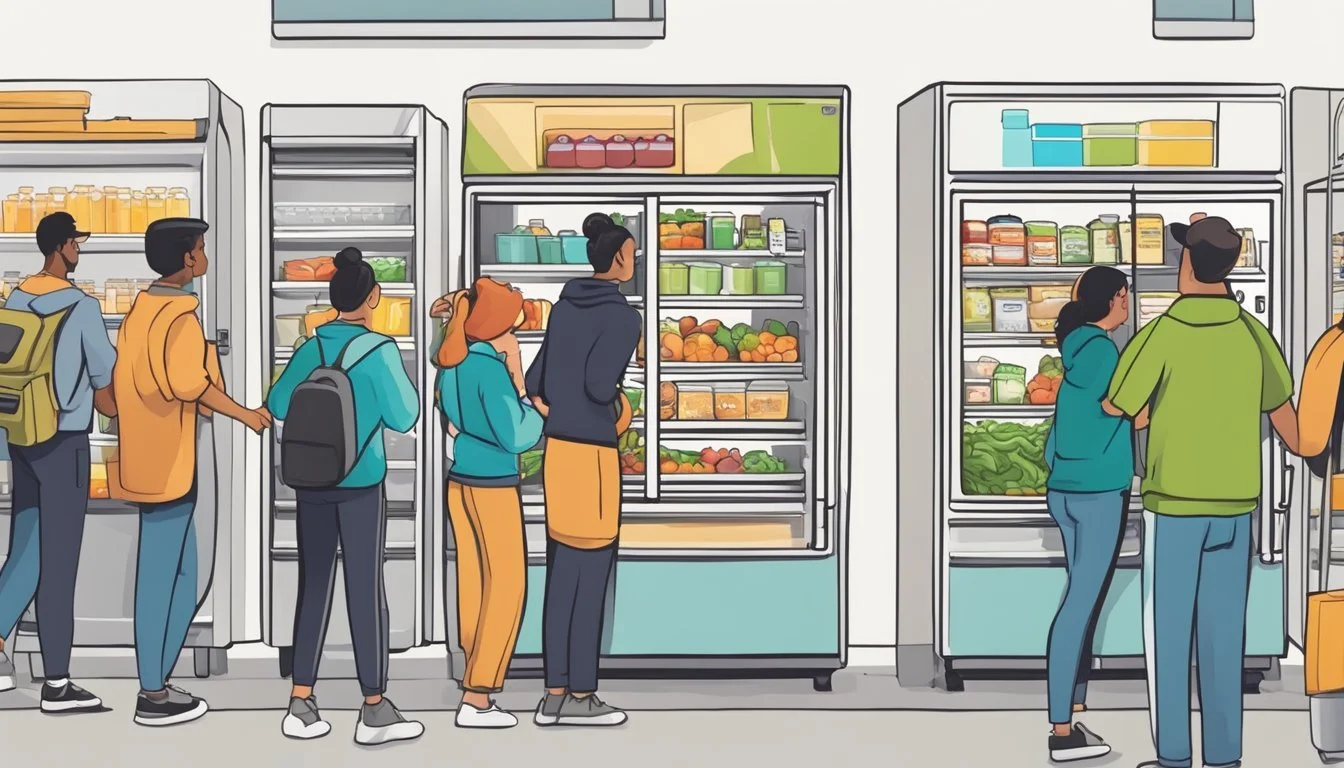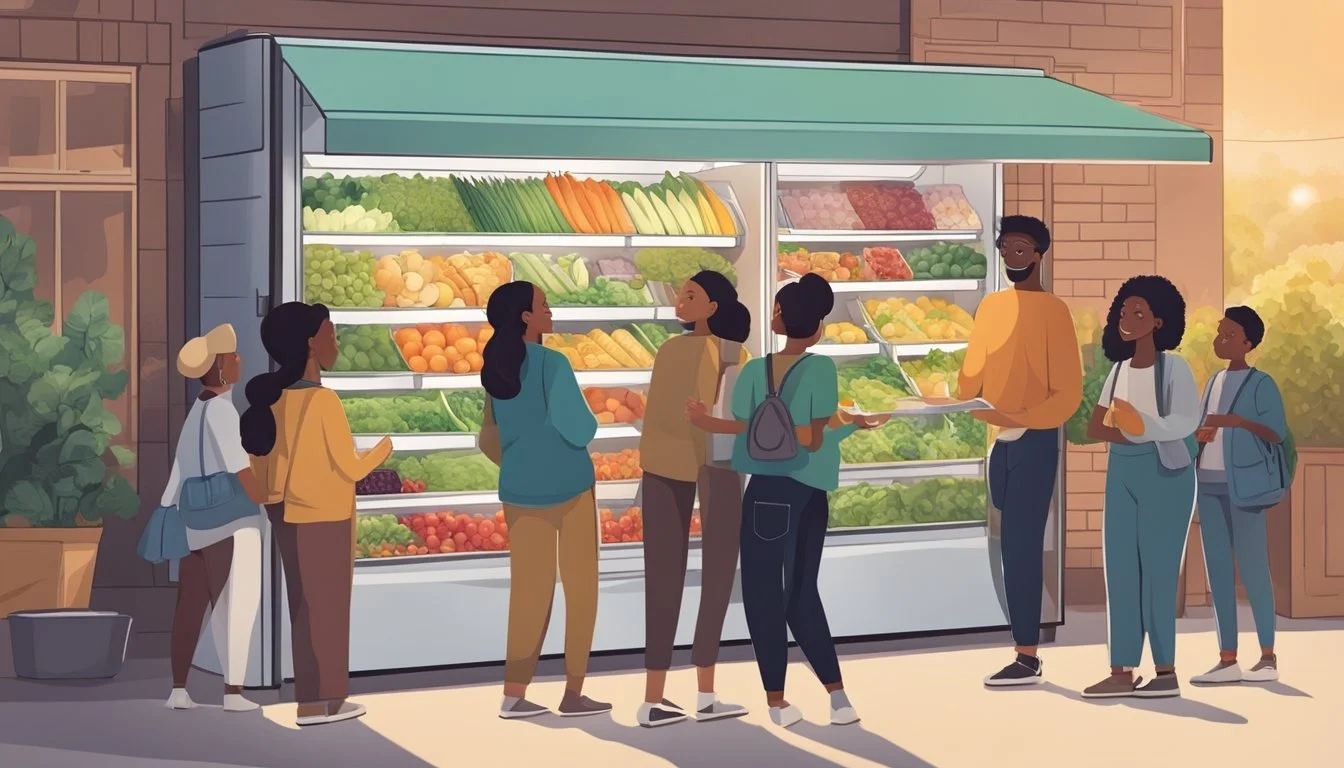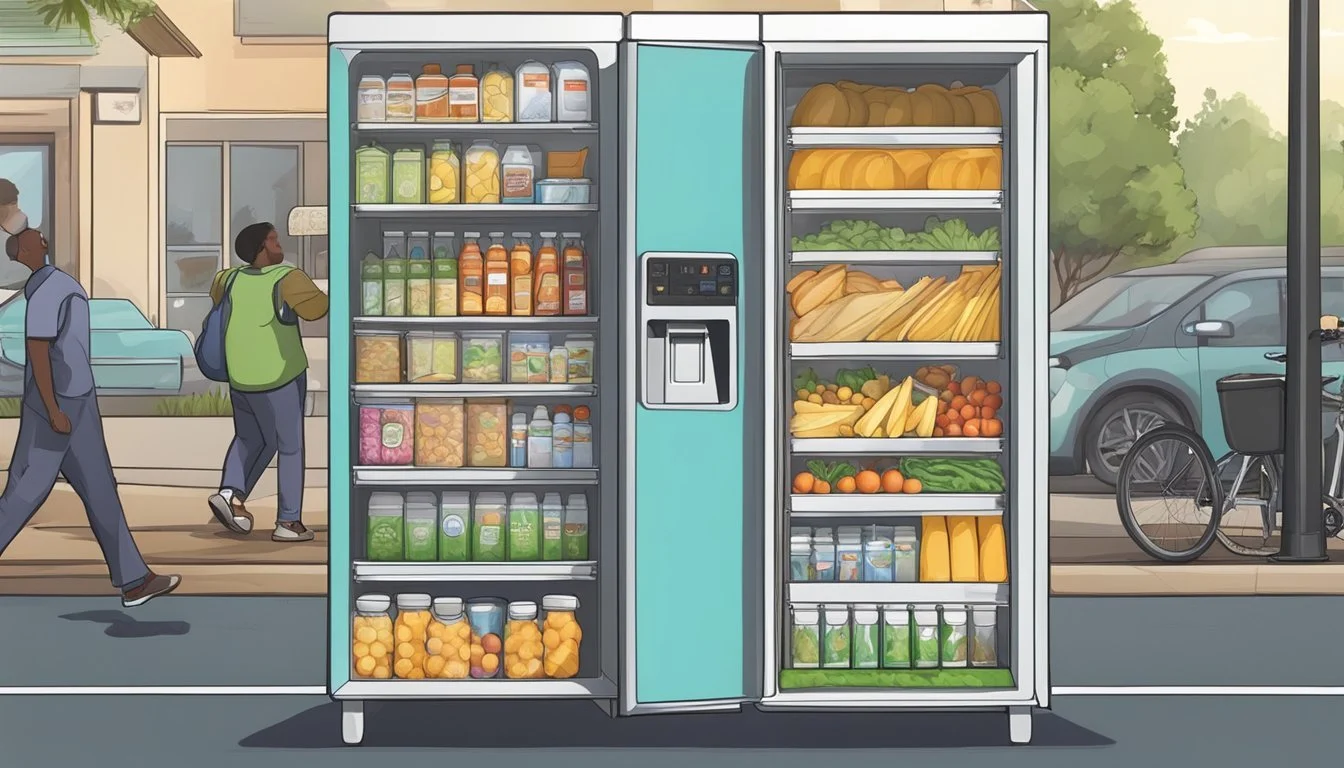Anaheim, CA Community Fridge
Nourishing Neighborhoods with Shared Resources
In Anaheim, California, a city grappling with a 15% poverty rate that has only intensified with the challenges of COVID-19, community fridges have become an innovative solution to address food insecurity. These community fridges, placed strategically around the city, offer free, accessible food to residents who are in need, creating a grassroots form of food sharing. The efforts to establish a community fridge network in Anaheim are part of a larger movement aimed at reducing food waste, providing nutritional options, and strengthening community bonds through shared resources.
The concept behind the community fridge is simple: anyone can take what they need or leave what they don't, promoting an environment of sharing and caring within the community. It's not just food that's exchanged, but also stories, art, and ideas, fostering a sense of connection and social responsibility. This effort is part of a broader initiative to not only feed the hungry but also to spark a conversation on food insecurity, sustainability in food systems, and community resilience in the face of economic and health crises.
Beyond addressing immediate needs, these fridges serve as a hub for community involvement and action. Residents are encouraged to participate by stocking the fridge with excess or unused food, thereby directly contributing to resource sharing and reducing waste. Through this simple act of giving, community fridges in Anaheim have become beacons of hope and solidarity, embodying a collective approach to tackling the challenges many face in accessing affordable and healthy food.
History and Concept of Community Fridges
Community fridges serve as decentralized means to address food insecurity and combat food waste. They stand as a testament to community solidarity and a shared effort to provide free access to food.
Roots of The Community Fridge Movement
The community fridge movement originated in Germany, where a group named Foodsharing facilitated the creation of the very first community fridges. The idea found fertile ground and quickly spread to other parts of the world, including Spain in 2015. These grassroots initiatives stem from a long-standing movement of sharing and sustainability. Community fridges are more than just food repositories; they represent a collective approach to supporting those in need and making use of food that would otherwise go to waste.
Expansion Beyond New York City
New York boasts a rich history of community fridges, often referred to as "Freedges". Businesses, organizations, and individuals in New York have successfully collaborated to maintain community fridges across the city, ensuring that they are stocked with a variety of items like fresh produce and packaged goods, accessible to anyone at any time. Following this blueprint, cities such as Los Angeles have embraced the concept, with community fridges popping up to bring free, fresh food to different neighborhoods. The Los Angeles Community Fridge initiative draws inspiration from both international roots and its own regional adaptations, creativity flourishing within these urban spaces.
Anaheim's Response to Food Insecurity
In Anaheim, community-led efforts and official programs are tackling the dual challenges of food insecurity and food waste, especially since the onset of the coronavirus pandemic, which exacerbated these issues.
Local Initiatives and Free Food Programs
The city of Anaheim has witnessed the rise of grassroots movements like the Community Fridge Network in response to increasing food insecurity rates. Community fridges, strategically placed throughout the city, provide free, accessible, and nutritious food to those in need. They operate under the principle of taking what you need and leaving what you can, lowering barriers to food access for the community. In light of the coronavirus pandemic, these initiatives have become even more crucial.
Impact on Food Waste Reduction
Alongside addressing food insecurity, Anaheim's free food programs have a positive environmental impact through food waste reduction. By redistributing surplus food that would otherwise go to waste, community fridges encourage a sustainable cycle of food sharing. This not only aids in feeding the hungry but also contributes to a significant decrease in the amount of food waste that burdens landfills and the environment.
Operational Aspects of Community Fridges
Community Fridges in Anaheim operate through a collaborative network involving local businesses, organizations, and volunteers, ensuring regular stocking and compliance with food safety regulations.
Funding and Support
Funding for the Anaheim Community Fridge often comes from a mix of sources that might include:
Local business donations, both financial and in-kind, like shelf-stable goods or eggs.
Crowdfunding campaigns aimed at individuals who wish to support the initiative.
Sponsorships or grants from organizations that recognize the fridge as an essential community resource.
Volunteer Coordination
Volunteers play a critical role in the Anaheim Community Fridge operations:
Regular Maintenance: They ensure the fridge is clean and that the food stocked is fresh and safe to consume.
Stocking the Fridge: Coordinated through schedules, volunteers help in restocking donated items from businesses and individuals, including perishables like eggs.
Outreach: Volunteers also engage in outreach to secure ongoing donations and raise awareness.
Food Safety Regulations
Anaheim Community Fridges adhere to food safety regulations to protect public health:
Perishable Foods: Care is taken to ensure items like eggs are stored properly, maintaining the required temperature to prevent spoilage.
Sanitation: Regular cleaning schedules are maintained, and sanitization procedures are followed according to health guidelines.
Food Handling: Volunteers are often trained in proper food handling techniques to minimize the risk of contamination.
Community Engagement and Contributions
In Anaheim, the collaboration between local businesses, individual donors, and the broader community has been integral to the success of the Community Fridge initiative. This section examines the specific roles played by these stakeholders in promoting food sharing and reducing food insecurity in the local community.
Role of Local Businesses
Local businesses in Anaheim have been pivotal in supporting the Community Fridge project. They contribute by:
Provisioning space: Some businesses provide physical spaces to host community fridges, making free food accessible to individuals in need.
Donating surplus food: In an effort to reduce food waste, businesses donate excess food items that are still suitable for consumption.
Individual Donors and Participation
The individual members of the Anaheim community play a vital role in the Community Fridge network, showcasing the power of collective action. Their contributions include:
Donating food: Residents participate by donating food directly to the fridges, offering a variety of nourishing options beyond non-perishable items.
Volunteering: Community members volunteer for maintenance and organization of the fridges, ensuring the initiative operates smoothly.
Environmental Impact and Sustainability
The Community Fridge initiative in Anaheim, CA, is a progressive step towards environmental sustainability, addressing the urgent need to curtail food waste and promote local agriculture.
Reducing Food to Landfills
The Community Fridge directly impacts the environment by diverting edible food from landfills. It provides a platform where excess food can be shared instead of being discarded. The average person might not be aware, but the food decomposing in landfills releases methane, a potent greenhouse gas. By redirecting food surplus to those in need, Anaheim's Community Fridge is curbing this methane emission. Here are some specifics:
Anaheim's Food Waste Contribution: An estimated 15% poverty rate indicates a potential high volume of food insecurity and, by extension, food waste.
Community Fridge Intervention: With community-wide participation, the fridge helps to:
Reduce the amount of waste going into landfills.
Mitigate methane emissions.
Community Gardens and Local Farms
Local gardens and farms are intrinsically sustainable as they foster short supply chains and encourage local consumption. Anaheim's movement towards using community gardens and local farms signifies a commitment to both community sustenance and ecological wellness. Key contributions include:
Support for Local Produce: Promotes the use of fresh, seasonal produce, reducing the carbon footprint from transportation.
Educational Opportunities: Community gardens become a living classroom for sustainable practices.
By embracing community fridges and supporting local agriculture, Anaheim is making strides in environmental stewardship and sustainable living.
Finding and Utilizing a Community Fridge
Anaheim has embraced the community fridge concept, providing free, accessible food for those in need. This effort helps to tackle food insecurity and reduce food waste by enabling residents to either contribute or take food items according to necessity.
Locating Fridges Through Maps and Apps
Residents can find the nearest community fridge in Anaheim by using maps and apps specifically designed for this purpose. ChangeX provides an interactive map that showcases various fridge locations within the Community Fridge Network. Additionally, community-driven platforms like Freedge may offer searchable databases or apps to connect users with their local fridge.
ChangeX Map: Lists community fridge locations and additional details like operation hours.
Freedge Database: Provides locations and possibly stories or events related to the community fridges.
Best Practices for Fridge Use
When using a community fridge, there are best practices to ensure it remains a sustainable resource for everyone. Donors should contribute fresh produce or non-perishable goods that are within their expiration dates and in good condition. Users of the fridges should take only what they need, keeping in mind the needs of others in the community.
For Donors:
Only donate food that is fresh and not expired.
Ensure items are in clean, unopened packaging.
For Users:
Take items considerately, based on necessity.
Maintain cleanliness for the next user.
By adhering to these guidelines, the community fridge remains a reliable and respectful space for all individuals seeking assistance or looking to reduce food waste.
Building a Network of Support
In Anaheim, California, a network of support around community fridges is essential to tackling food insecurity and promoting resource availability. This effort involves strategic organization and cooperation with local entities.
Formation of Community Fridge Networks
Community fridges in Anaheim represent a responsive initiative to meet the direct needs of those facing food scarcity. The Community Fridge Network, which functions on a grassroots level, is fundamental in orchestrating the distribution of free, accessible food. These networks operate as local pantries but with a unique twist: food is stored in publicly accessible refrigerators and is available to anyone without the typical restrictions of traditional food pantries. The fridges are often placed in accessible locations, ensuring that distribution is as efficient as it is generous.
Key components of the network include:
Location Selection: Strategically placing fridges in areas with the highest need.
Maintaining Stock: Regularly checking and restocking the fridges with fresh produce and perishables alongside non-perishable food items.
Collaborations and Partnerships
Collaborations and partnerships are integral to sustaining and growing the network. The organization liaises with local businesses, food donors, and volunteers to maintain the fridges. Partnerships are also formed with entities that can provide necessary resources such as electricity, which is vital for the operation of the fridges.
Business Contributions: Local businesses often support by providing surplus food, thereby reducing waste while contributing to community well-being.
Volunteer Efforts: Volunteers are the backbone, helping with logistics and daily operations, ensuring the fridges remain clean and well-stocked.
By nurturing these relationships, the community fridge initiative in Anaheim enhances its reach and impact, becoming a reliable source of nourishment for many and a recognized symbol of communal support.
Looking Ahead
The Anaheim Community Fridge initiative is poised to make significant strides in addressing food insecurity and fostering community solidarity. These efforts are focused on sustainable growth and the provision of healthy food options to those in need.
Future Developments in Anaheim
Anaheim's Community Fridge is set to scale its operations, with plans to introduce more refrigeration units throughout the city. This effort aims at broadening the reach to more neighborhoods, particularly those witnessing higher rates of food insecurity. The initiative intends to collaborate with local businesses and civic organizations to create a wider network of support and ensure the fridges are well-stocked with nutritious food.
Upcoming Goals:
Increase the number of community fridges across Anaheim
Forge partnerships with local entities
Secure sustainable funding for upkeep and expansion
Expanding Access to Nutritious Food
The initiative stresses the importance of access to not just food, but nutritious food. Plans include partnering with local farms and markets to provide a steady supply of fresh produce to the community fridges. There is also an emphasis on community involvement; volunteer programs will be crucial in maintaining the fridges and educating the public about nutrition and food resources.
Nutrition Focus:
Secure Partnerships:
Local farms
Farmers’ markets
Grocery stores
Establish Volunteer Programs:
Fridge maintenance
Community workshops on nutrition










